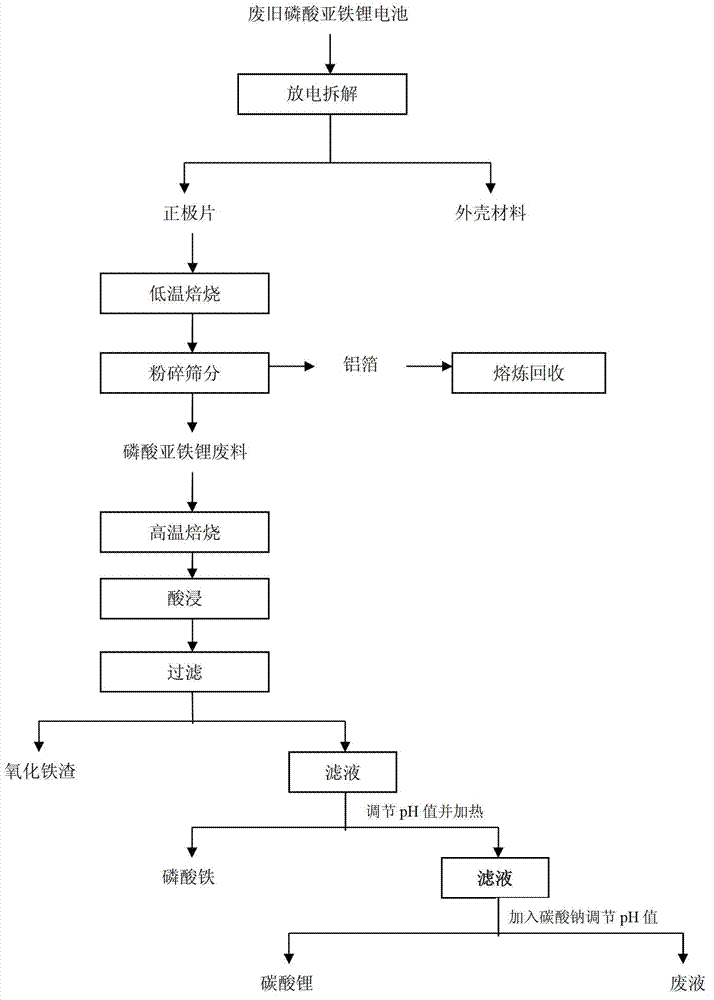Method for recycling lithium carbonate from lithium iron phosphate waste material
A technology of lithium ferrous phosphate and lithium carbonate, which is applied in the field of lithium carbonate recovery, can solve the problems that lithium ferrous phosphate cannot be satisfied, product consistency is difficult to be guaranteed, etc., and achieve the effect of solving the problem of resource recycling and low cost
- Summary
- Abstract
- Description
- Claims
- Application Information
AI Technical Summary
Problems solved by technology
Method used
Image
Examples
Embodiment 1
[0053] Embodiment 1 adopts the method of the present invention to comprehensively recycle and utilize lithium ferrous phosphate waste material
[0054] Discharge the residual power of the waste lithium ferrous phosphate power battery, disassemble the battery, take out the positive electrode sheet, and recycle the battery shell according to the classification of aluminum shell, steel shell, plastic, etc.; roast the lithium iron phosphate positive electrode sheet at 400°C for 1 hour, crush it and sieve it Separately recover the positive aluminum sheet; 100kg of lithium iron phosphate waste, lithium content 3.5%.
[0055] Roast lithium iron phosphate waste at 800°C for 1 hour, then add water to adjust the slurry, add 98% concentrated sulfuric acid to adjust the pH value to 0.5, filter to obtain a mixed solution of ferric phosphate, lithium phosphate, and ferric sulfate; heat the mixed solution to 80°C, add Alkali adjusted the pH value to 2.0, reacted for 4 hours, filtered to obta...
Embodiment 2
[0062] Embodiment 2 adopts the method of the present invention to comprehensively recycle lithium iron phosphate waste
[0063] Get 100kg of lithium ferrous phosphate waste produced in the battery production process, with a lithium content of 3.52%. Roast lithium iron phosphate waste at 600°C for 2 hours, then add water to adjust the slurry, add 98% concentrated sulfuric acid to adjust the pH value to 0.8, filter to obtain a mixed solution of ferric phosphate, lithium phosphate, and ferric sulfate; heat the mixed solution to 90°C, add Alkali adjusted the pH value to 2.3, reacted for 2 hours, filtered to obtain crude ferric phosphate, then washed with water at 60°C, and dried to obtain ferric phosphate; the filtrate was adjusted to a pH value of 7, added calcium chloride 100g, and then filtered to remove impurities; after removing impurities, the filtrate Adjust the pH value to 11 with sodium carbonate, react for 1 hour, filter to obtain crude lithium carbonate, wash with water...
Embodiment 3
[0069] Embodiment 3 adopts the method of the present invention to comprehensively recycle lithium ferrous phosphate waste
[0070] Get 100kg of lithium iron phosphate waste produced in the production process of lithium iron phosphate, and the lithium content is 4.38%. Roast lithium iron phosphate waste at 500°C for 4 hours, then add water to adjust the slurry, add 98% concentrated sulfuric acid to adjust the pH value to 1, filter to obtain a mixed solution of ferric phosphate, lithium phosphate, and ferric sulfate; heat the mixed solution to 100°C, add Alkali adjusted the pH value to 2.5, reacted for 1 hour, filtered to obtain crude iron phosphate, then washed with water at 80°C, and dried to obtain iron phosphate; the filtrate was adjusted to a pH value of 6, 100g of calcium chloride was added, and then filtered to remove impurities; after removal of impurities, the filtrate Adjust the pH value to 10 with sodium carbonate, react for 2 hours, filter to obtain crude lithium car...
PUM
 Login to View More
Login to View More Abstract
Description
Claims
Application Information
 Login to View More
Login to View More - R&D
- Intellectual Property
- Life Sciences
- Materials
- Tech Scout
- Unparalleled Data Quality
- Higher Quality Content
- 60% Fewer Hallucinations
Browse by: Latest US Patents, China's latest patents, Technical Efficacy Thesaurus, Application Domain, Technology Topic, Popular Technical Reports.
© 2025 PatSnap. All rights reserved.Legal|Privacy policy|Modern Slavery Act Transparency Statement|Sitemap|About US| Contact US: help@patsnap.com



